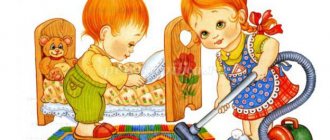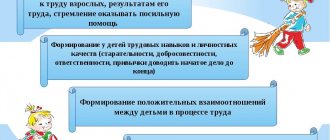Consultation for parents “Work education of a child in the family.”
Municipal preschool educational
institution "Kindergarten No. 73" in Magnitogorsk
Prepared by: teacher of the first qualification category
Dmitrieva Ekaterina Alexandrovna
Consultation for parents
“Labor education of a child in the family.”
Labor education is an important means of comprehensive development of a child’s personality. Hard work is not given by nature; it must be cultivated from early childhood. Thus, it is in the family that the foundations of labor education are laid.
If previously children worked from an early age, now many parents, due to their busyness and lack of patience, protect their children from work by doing everything themselves, thereby doing a “disservice.”
Labor activity is multifunctional. In the process of work, children develop physically and mentally, master skills and abilities. Parents don’t even think that the child’s work is connected with the need for active participation in the lives of adults and the desire for independence. Participation in household work allows children to really feel their involvement in the concerns of the family, to feel like a member of the family team. This helps to develop many important personality traits: responsiveness, caring, thrift, responsibility.
Work also has a significant impact on the mental development of a child. It develops intelligence, curiosity, initiative, active perception, observation, attention, concentration, and trains memory. And work also develops thinking - the child has to compare and contrast objects and phenomena with which he deals.
Identify the basic principles of labor education
children in the family:
— introduction to work through self-service; — a gradual transition from self-service to work for others; — gradual expansion of the range of responsibilities, increasing their complexity; — tactful and constant quality control of the execution of work assignments; — organization of training in performing labor operations; - developing confidence in the child in the importance of performing the work assigned to him; — taking into account the individual characteristics and inclinations of the child when distributing work assignments; - encouragement of diligent execution of assignments, manifestation of independence and initiative; - alternation of work and rest, as well as different types of work in the regime.
So, in a family, work for children should be feasible
. A child may have household chores that he performs constantly. For example, taking care of your shoes, clothes, toys. At an older age, the child can already wash his own dishes, care for pets, water indoor plants, etc. And it is not at all necessary to entrust the child with cleaning the entire apartment; you can, for example, ask him to wipe the dust from the window sills or help his mother prepare dinner.
Remember, when giving instructions to children, it is necessary to clearly explain what is being done, why and why.
The child needs to know why he needs to perform certain tasks and what result should be achieved. We need to tell for what purpose we are doing this or that work. For example, if flowers are not watered, they may die; If we don’t wash the dishes, we’ll have to eat from dirty dishes. It is necessary to help the child feel the benefits of his work efforts, to teach him to experience joy because his activities are useful.
Never force your children to help you.
Coercion is disgusting. Moreover, such work will not differ in quality. Help must come from a pure heart. It is clear that the child may not notice that it is difficult for you and that you would not mind accepting help from him. Here you can cheat a little: groan and groan: “Oh, how tired I am,” “Oh, my back hurts.” It’s a rare child who doesn’t realize that his help would be in place.
Teach children to finish the work they start.
, do not rush or push them, know how to wait until they complete the work themselves.
Work is no less attractive for a child than play. You can use work-play as a means of developing children's activity.
Playful images help children do their work with great interest. It is easier to teach a child to work while playing. For example, your house is a spaceship, and it needs to be cleaned before departure. Young children easily humanize inanimate objects - this quality can be used effectively. Tell your child on behalf of the toy that it is cold for her to lie on the floor, or let the bear ask to be put on the shelf.
Gradually, the child develops a positive attitude not only to those types of work that are associated with play, but also to those that are not so interesting, but necessary, that is, there is an awareness of the importance of work activity.
The work of children should not go unnoticed by adults. It is necessary that work brings pleasure to the child. Praise him for the results he has achieved
. Praise can be expressed in words or by organizing joint family entertainment (a trip to the cinema, park, etc.); in no case should you reward your child with money, this can develop the skill of doing everything for money. Any work should be rewarded, even if the child did something wrong. And if he breaks something, don’t even think about scolding him, because the child wanted to help. Work and its results should always be accompanied by positive emotions.
In parallel with this, it is necessary to instill in children respect for the work of adults
, careful attitude to its results. Words of notation, as you know, are unconvincing methods for a child. He must see the good example of adults. The activities of adults serve as role models for children. If the adults themselves work with enthusiasm, then the child will strive for the same. When a child sees that work for adults is a heavy burden, then he himself will have the same attitude. Therefore, parents themselves should take on any work with desire, diligence and responsibility, setting a good example for their children. When a child in a family hears stories from parents about their work and the production activities of other people, this expands the child’s understanding of the work of adults, their professions, and forms interest and respect for the work activities of their parents.
Tips for parents:
1. Be consistent in your demands.
2. Consider the individual and age characteristics of your children.
3. Before entrusting something to a child, show an example of the correct execution of the assignment, teach this to your son and daughter, and complete the assignment several times together.
4. Do not forget about playful moments in the labor education of children.
5. Teach your child to respect the work of other people and take care of the results of their work. Tell your children about your work and your friends.
6. Encourage your child more often for independence, initiative, and quality of work performed.
7. Tactfully evaluate the results of your child’s work.
Methods of labor education for preschool children
In kindergarten, the initial foundation of hard work is formed. Educators teach children to engage in activities that are beneficial to society. Training must be carried out in a playful way, since this type of activity is the leading one for preschoolers.
Children need to be taught from an early age the need to help their parents
You need to raise a child gradually, as he will have to master several stages. He will have to develop skills, be able to set goals, plan his work and achieve results.
Important! At preschool age, children have only external motivation, i.e. they need financial incentives.
At preschool educational institutions, teachers help children master the first tools of labor. The teacher also sets goals and monitors their achievement - this is good to develop through self-service skills.
The role of family traditions
The position of an adult when teaching a child work activities is helping. For example, if a baby asks to lace his shoes, then the parent does not need to sit him on a chair and do it for him. The right thing to do would be to show him how it’s done and help him cope with it himself.
It is necessary to develop social and everyday skills in the child
Nurturing hard work in preschoolers depends on various factors. Mastering simple skills begins with observing an adult. If parents often clean, wash dishes, etc., then the baby will begin to try to repeat after them.
At the age of 3, the child develops the need “I myself.” It is from this moment that you can begin training.
The relevance of the correct position of an adult
Educators can offer the brochure “Labor education in the family”; the consultation for parents contains practical advice and common mistakes. Moms and dads should systematically teach their children to do housework.
Some adults mistakenly ask a child to help only upon express request. This attitude interferes with proper teaching. Sometimes parents take an overprotective position. They do everything for the child, suppress his independence and initiative.
Close people should help the child cope with various tasks. For example, let him dress on his own and get ready for a walk.
Important! Don't expect your child to do it perfectly the first time.
Teaching children work skills begins with demonstrations of action. The parent should provide support for the slightest attempts to do something independently. For example, wipe the floor. Even if a child just rubs the dirt, initiative should be encouraged.
If an adult begins to overprotect the child, he will quickly get used to being lazy and will have no desire for personal activities.
Methods and forms of labor education
MAGAZINE Preschooler.RF
Round table with parents on the topic: “Labor education in the family.” Topic: “How to instill hard work in a child?”Goal: developing the competence of parents in the issue of labor education of children.
Tasks:
- introduce parents to the peculiarities of labor education of children in the family
- characterize the content of a child’s interest in work, taking into account age characteristics in the process of labor education in the family
- cultivate positive relationships in the process of work between children and adults.
Progress of the event:
Introductory part
Hello, dear parents! Thank you for taking the opportunity to come to today's meeting.
And I want to start our communication with the memories of the serf peasant Fyodor Bobkov. Here's what he wrote about his childhood:
“My participation in the work consisted of winding threads on small bobbins for weaving calico. During the summer, my responsibility was to babysit my brother and sister, who were younger than me. During the harvest, I stayed alone with them in the house. I didn’t bother with them very much - I gave Petrushka a piece of bread, Katya a pacifier and ran off to play with the boys, completely forgetting about my pets. Occasionally our neighbor, Aunt Matryona, would shout at me for leaving the children unattended, then I would return home, shove a piece of bread into one’s mouth, a pacifier into another’s mouth, and run away again. Until winter I ran barefoot, and in winter I walked in bast shoes.” .
It was not without reason that I read this excerpt from my memoirs. Each of us, listening to this passage, was mentally transported to those distant times. They introduced this little boy and drew a parallel with children today.
Perhaps there was some kind of special education system for peasant children, but most of them grew up in their natural environment and learned everything new themselves, getting their bearings.
Much has changed in our lives and in the lives of our children. The school curriculum has become more complicated, and it has become more difficult to study. So parents make a “sacrifice”: they take on all the housework themselves.
We want our children to live better than we do, and we free them from all workload, from all responsibilities, for some reason thinking that living “better” means living without doing anything.
And today we have gathered together to understand this difficult issue.
I propose to split into two groups. We will be equally interested to hear the opinions of fathers and mothers. In the first group we will only have mothers, and the second group will consist of fathers.
And so, we begin.
Practical part:
1. WHAT DOES IT MEAN to prepare a child for life? What is the main guarantee that this life, so dear to us, will be lived beautifully, brightly, and profitably? We will probably not be mistaken if we say: the main thing is to teach people to love work and find a source of joy in it.
To begin with, I will ask the members of both teams to define the concept of “hard work” . What do you think the concept of hard work includes?
- This is the moral quality of a child’s personality, manifested in his awareness, responsibility, satisfaction with the work process, the child’s interest in achieving useful results of his work, and a positive attitude towards the work of an adult.
— Hard work is a character trait that consists of a person’s positive attitude towards the process of work.
(task analysis)
2. And now I propose to play the “Yes - No” . There are cards with questions on the tray; you need to divide these cards into three groups. The first group is those tasks that your child most often performs at home. The second group is those tasks that the child rarely performs. And third, these are those instructions that the child does not complete at all. At the end of the game we will analyze the result.
List of instructions:
- Assist parents in cleaning the apartment.
- Cleans up his desk and his room.
- Take care of your younger brother or sister.
- He washes his small things.
- Washes tea (or other) dishes.
- Keeps shoes clean.
- Takes out the trash.
- Feeds pets, birds, aquarium fish.
- Walks with a dog, cat.
- Goes to the store independently (for bread, milk, etc.).
- Takes care of plants.
- Helps with food preparation (washes vegetables for salad, rolls out dough)
- Sets the table and clears the table.
- Glues books and board game boxes.
- Performs feasible work on the plot.
- Makes his bed.
(task analysis)
What kind of help with housework can preschool children provide? The range is quite wide. Remember, when giving instructions to a child, it is necessary to clearly explain what is being done, why, and why. The child needs to know why he needs to perform certain tasks and what result should be achieved. This is the only way for preschoolers to form an idea of the need for these actions.
3. Among modern scientists there is an opinion that labor should not be divided into “male” and “female” . Do you agree with this opinion? If not, why not?
Parents should know that both girls and boys need to be taught to do all types of homework equally. It is necessary that boys and girls equally learn to do everything necessary around the house and not consider doing this work as something unworthy of themselves. Anyone who has observed children knows that in early childhood, boys are just as willing as girls to help their mother cook, wash dishes, and do any housework. But usually in families, from a very early age, differences between boys and girls begin to show.
I will ask the team of mothers to describe the work activities of the boys, and let the fathers determine work assignments for the girls.
Labor education of girls
Girls need to be involved in household work: taught to clean the house, do laundry, cook simple meals, and set the table. Such activities should be unobtrusive and properly organized so that the baby becomes more and more willing to help her mother. The daughter needs to understand that they need her help. As you grow older, you need to add more complex tasks: handicrafts, caring for the younger ones. Working together, mother and daughter develop mutual understanding. In the future, all this will have a positive impact on caring for elderly parents.
Labor education of boys
The best example for a son is his father. If dad sits on the couch all day long and does not help his wife, then most likely the boy will not grow up to be a hard worker.
Depending on the age of the baby, dad can assign various work activities: helping during the repair of any items, giving tools, assisting with work in the garden or garage. A common cause promotes rapprochement and improvement of relationships. Repairing some simple household appliances can be turned into an interesting activity, stimulating the child’s greater interest.
(task analysis)
4. Each team has a list of ways to involve a child in work. Your task is to rank these methods in your opinion according to the principle of effectiveness. Which of these methods is the most effective in your opinion and why?
- Request
- Compulsion
- Promotion
- OK
- Gratitude
- Competition
- Punishment
A request is the best and gentlest way of addressing, but you should not abuse the request. The request form is best used in cases where you know well that the child will gladly fulfill your request. If you have any doubt about this, use the form of an ordinary order, calm, confident, businesslike.
Coercion can be different - from a simple repetition of an order to a sharp and demanding repetition. In any case, you should never resort to physical coercion, since it brings the least benefit and causes the child to have an aversion to the work task.
Encouragement - approval, gratitude, awards expressing the advantages of evaluating the child’s activities.
Approval is a simple type of encouragement.
Gratitude is on a higher level.
Competition is a method of directing the natural need for competition and priority in cultivating the qualities needed by a person and society. Efficiency increases if the tasks are determined by the children themselves.
Punishment – this issue is still debated. It should prevent unwanted actions, slow them down, and cause a feeling of guilt towards oneself and other people.
The biggest challenge for parents is how to deal with so-called lazy children. Laziness develops in a child due to improper upbringing, when from a very young age parents do not instill in the child energy, do not teach him to overcome obstacles, do not arouse in him interest in the family household, do not instill in him the habit of work and the habits of those pleasures that work always delivers. There is only one way to combat laziness: gradually drawing the child into the field of work, slowly arousing his interest in work.
4. So, in a family, work for children should be feasible. A child may have household chores that he performs constantly. For example, taking care of your shoes, clothes, toys. At an older age, the child can already wash his own dishes, care for pets, water indoor plants, etc.
You have cards on your tables with various situations that can happen in the family. We need to discuss them and, if possible, formulate rules that will help raise a hardworking child.
A) The child does not have time to complete your instructions on time, because he is too slow and clumsy in his movements. How to proceed?
(Give extra time. You can, of course, peacefully offer your help: “Well, how are you doing? Let’s go together, do you want?” But if you can be patient and allow your son or daughter to finish what they started, this is more correct.)
B) The child completed the assignment: he cleaned his room. Clearly he tried. To thank or not to thank? And how to thank?
(A kind word from parents is an important reward. You need to show that you appreciate his work. After all, cooking dinner for you is a common thing, but it’s nice to hear praise. Let him feel that you consider him an adult.)
(task analysis)
5. Labor education of preschoolers is carried out using a number of means: children’s own labor activity, familiarization with the work of adults, artistic means.
Which of the three is the leading remedy and why?
Labor activity is the leading means of labor education. Children's own labor activity is a necessary means of labor education.
Familiarization with the work of adults. This tool allows you to expand the child’s understanding of the content of human activity, the social significance of work, and the attitude towards work.
Artistic media: fiction, music, visual arts. With the help of this group of tools, children form ideas about the content of work, about people’s attitude towards work, about how others evaluate the work of other people, etc.
Homework
Dear parents, at the end of our meeting I would like to ask you to participate in the creation of the book “My Family’s Labor Traditions” . Write about your family work traditions. What work traditions do you have in your family? Do children need them? Place photographs and drawings about your family work on the pages. Share your experience and interesting information. We will put all the pages into our “work” book. We will update it with interesting work events. This will be your homework
Final part:
Let's summarize our meeting. Let's answer the questions that we posed at the beginning of our conversation: Why is it necessary to instill a love of work in children?
To the question: “How to educate through labor?” We also tried to answer. The following were presented to your attention and for discussion: forms, methods, principles, conditions, rules for organizing labor activity. I hope that today's meeting helped you understand the very important issues of labor education. And I really hope that many of you will take advantage of our tips and recommendations.
— Once, one restless mother asked the great teacher A. S. Makarenko:
— “At what age should you start raising a child if he is now 9 months old?
- You are exactly 9 months late! - answered Makarenko.
I would like to wish all of us that we would never be late in matters of education.
Thank you all for your participation. See you again!
Literature:
- A. S. Makarenko. "Family and raising children" . Tutorial. M. Pedagogy, 1984.
- L. A. Kulik. Family education: Textbook, M. Education, 2003.
- Pashkov A.G. Labor as a means of education//Pedagogy, 1992, No. 7-8.
- Kaleidoscope of parent meetings. Methodological developments. Issue 1. / E.N. Stepanova - M.: Creative Center, 2001.
- Dialogues about education. / Book for parents. - M.: Pedagogy, 1985.
| Next > |
Practical advice
It’s not for nothing that teachers develop consultations for parents “Labor education for preschoolers.” It is this period that is very important for the formation of the first ideas about social and everyday skills.
When to start
Not only when being in a group, a child must follow the rules. At home he also runs errands and does various jobs. From an early age, he is taught to put toys in place, clean up after himself, and help his parents.
In kindergarten, teachers also develop independence, but this is not enough. Therefore, parents are also full participants in the process.
Education of hard work in preschool children takes place under the supervision of adults. They are the ones who help develop habits and skills. This process takes several years, so you need to do it from the baby’s first year.
Important! There are no uniform teaching methods, but it is worth adhering to two principles - consistency and systematicity. In this case, you will be able to achieve your goals.
How to teach a preschooler to work
In the first year of a child's life, parents gradually teach him to put toys in their places. To do this, he is shown how to put them in a box or container. This needs to be done in a playful way.
After completing the task, the child must be encouraged
Educational institutions may hold parent meetings on “Family Traditions and the Child’s Ability to Work.” All this is aimed at ensuring that adults receive practical advice on parenting.
Before starting kindergarten, children must learn to care for themselves. To do this, they are taught to wash their face, brush their teeth, comb their hair, get dressed, etc.
Important! First, the parent shows how to do it, then helps to carry out the actions.
Different methods of labor education are aimed at achieving one goal - developing the need to carry out useful activities. To do this, parents ask for help in arranging washed dishes, wiping off dust, etc.
The tasks should be age appropriate. The components of activity are goal, motive, means and result. The education process is built on the basis of them. For example, the child is told that toys need help and need to be put in their places.
A tool is something that helps to carry out an activity. The child needs to use cutlery to eat. Therefore, he will need different skills and abilities in life.
The educational potential of the labor activity of preschool children allows us to consider it useful for society. What a person will be like in the future depends on this. He must have the right attitude towards work.
A person’s success directly depends on hard work
It’s worth working with schoolchildren a little differently. From the first grade they can already be assigned different tasks. It is better to write them all down in a list that will help him remember everything.
Topics of labor education events in schools and kindergartens
Important! Developing the habit of studying also requires a special approach. Therefore, if a child is assigned to write an essay, the parent can tell him where to look for information. But don't try to do the job for him.
MBOU "Elementary school - kindergarten No. 8"
Prepared by:
teacher of the 2nd junior group No. 2
Dobrodomova E.S.
Goal: developing the competence of parents in the issue of labor education.
Objectives: to attract the attention of parents to awareness of the importance of labor education in the life of a child. Arouse parents' interest in joint work with their child at home.
Labor education is an important means of comprehensive development of a child’s personality. Hard work is not given by nature, but must be cultivated from early childhood. The main purpose of work is its influence on the child’s personality. Reasonably organized work strengthens the physical strength and health of the child. Movements become more confident and accurate. As he acts, the baby becomes more and more oriented in space.
Work also has a significant impact on the mental development of a child. It develops intelligence, curiosity, initiative, active perception, observation, attention, concentration, and trains memory. And work also develops thinking - the child has to compare and contrast objects and phenomena with which he deals. Emphasizing the invaluable importance of work for the comprehensive development of a child’s personality, I bring to your attention some recommendations for labor education in the family.
The work of children in the family must be feasible. It is not at all necessary to entrust cleaning the entire apartment to the baby, but asking him to wipe the dust from the windowsill is quite possible. Use the opportunity - interest. Any child is interested in working with a vacuum cleaner. He won’t work much, of course, but he will gain some skills.
At the first stages, work activity is not stable; it is closely related to children’s games. The connection between work and play is important in preschool age - play images help children do work with greater interest. It is easier to teach a child to work while playing. For example, your house is a spaceship, and it needs to be cleaned before departure. Young children easily humanize inanimate objects - this quality can be used effectively. Tell your child on behalf of the toy that it is cold for her to lie on the floor, or let the bear ask to be put on the shelf.
Never force your child to help you. Coercion is disgusting. Moreover, work done under duress is not of high quality. Help must come from a pure heart. It is clear that the child may not notice that it is difficult for you and that you would not mind accepting help from him. Here you can cheat a little: groan and groan: “Oh, how tired I am,” “Oh, my back hurts.” It’s a rare child who doesn’t realize that his help would be in place.
What kind of help with housework can preschool children provide? The range is quite wide. In addition to cleaning his room, the baby can help his mother prepare for dinner, for example, in setting the table. The child is quite capable of watering indoor plants and feeding pets.
Remember, when giving instructions to a child, it is necessary to clearly explain what is being done, why, and why. The child needs to know why he should perform certain tasks and what result should be achieved.
This is the only way for preschoolers to form an idea of the need for these actions. Therefore, we always need to explain why we are working. For example, if flowers are not watered, they may die; If we don't wash the dishes, we'll have to eat from dirty dishes.
The work of a child should not go unnoticed by adults. Any work should be encouraged: thank the child, praise, appreciate his efforts. Even if the child did something wrong. And if he breaks something, don’t even think about scolding him, because the child wanted to help. Work and its results must be accompanied by positive emotions. Gradually, the child develops a positive attitude not only to those types of work that are associated with play, but also to those that are not so interesting, but necessary, that is, there is an awareness of the importance of work activity. The activities of adults serve as role models for children. If the adults themselves work with enthusiasm, then the child will strive for the same. When a child sees that work for adults is a heavy burden, then he himself will have the same attitude. Therefore, parents themselves should take on any work with desire, diligence and responsibility, setting a good example for their children.
Teach your child to complete the work he has started, do not rush or rush the child, know how to wait until he completes the work himself.
In parallel with labor education, it is necessary to instill respect for the work of adults and a careful attitude towards its results. Words of notation, as you know, are unconvincing methods for a child. He must see the good example of adults.
Only the systematic fulfillment of work duties will help to develop preschoolers’ organization, responsibility, and habits of work effort, which is so important for preparing a child for school.







